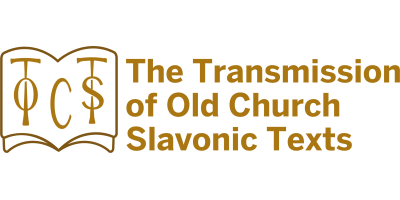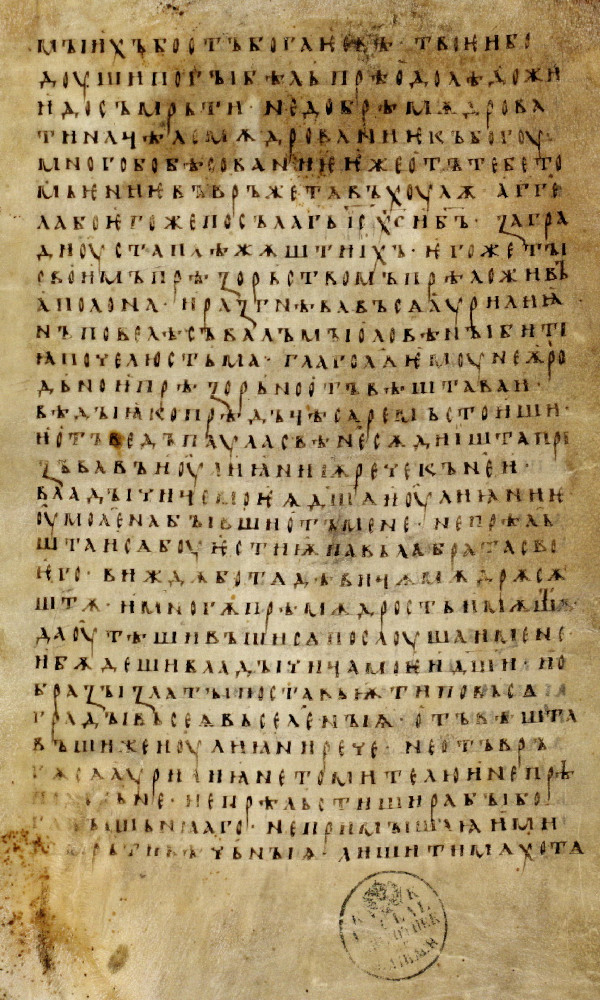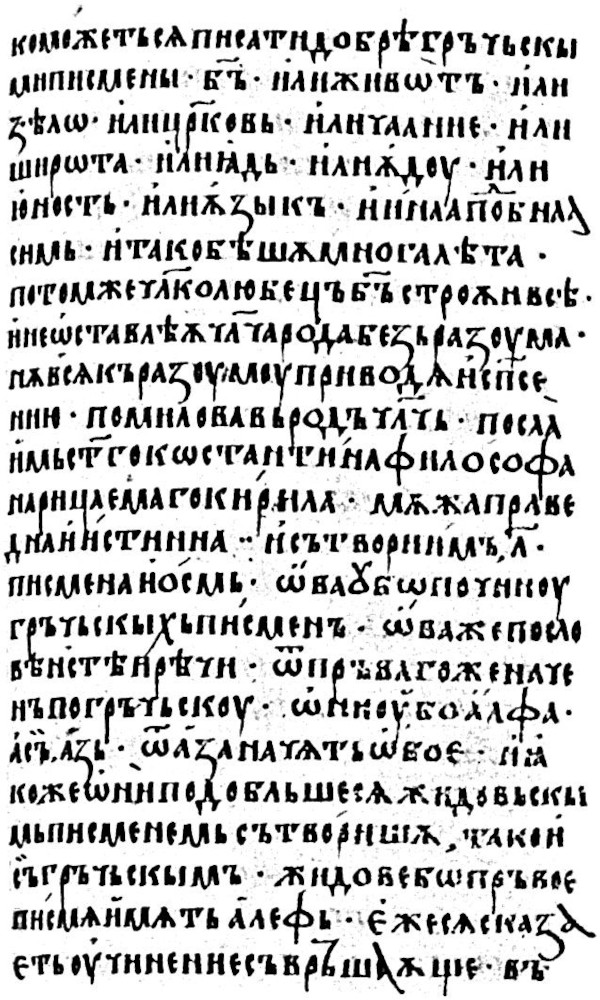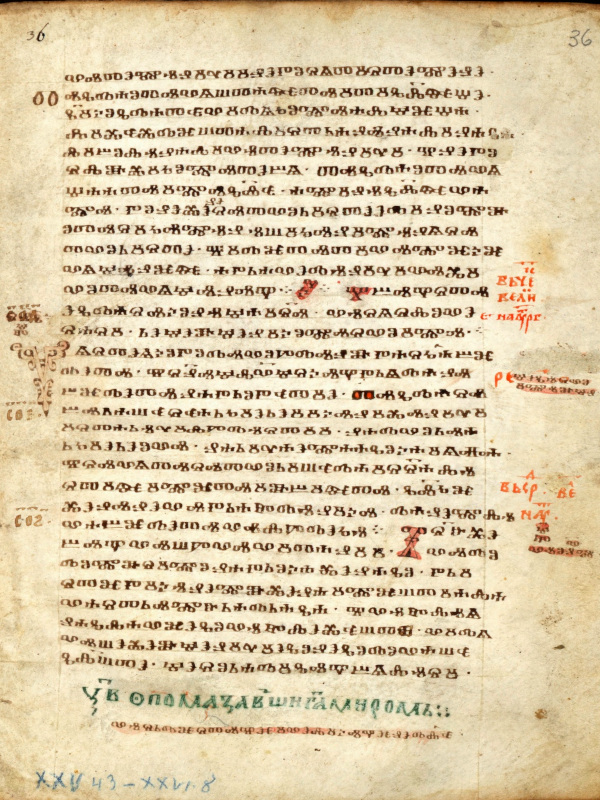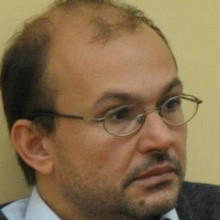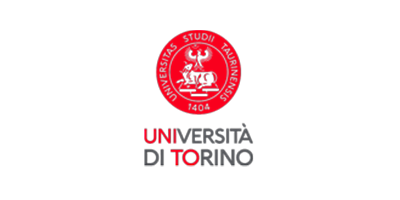TOCST
The Transmission of Old Church Slavonic Texts
Project
The TOCST’s intended goal is to offer new tools in further advancing our knowledge in the textual transmission of Old Church Slavonic writings, that is, the literature of Slavia Christiana (9th - 11th centuries). Slavic philology, unlike Byzantine, Middle-Latin, German and Romance philologies, is still lacking in a truly comprehensive examination of the transmission of the most important Old Church Slavonic texts, which in many cases continue to be studied on the basis of a fragmentary and incomplete investigation of the manuscript sources. Instead of selecting a handful of works retrieved from the earliest Glagolitic and Cyrillic manuscripts (late 10th - 11th centuries) as a starting point, we propose to focus on the 14th and more importantly the 15th and 16th centuries as a key-period for the investigation. This is in contrast with a longstanding tradition in our discipline to focus on earlier testimonies, whereas many ancient traits of Old Church Slavonic – as far as vocabulary and syntax are concerned – are to be found also (and sometimes only) in more recent manuscripts. Such an outdated traditional practice had grave consequences for an assessment of the works belonging to the earliest body of Old Church Slavonic literature. As a result, a large number of texts were insufficiently studied merely on the grounds that they are not attested in the earliest manuscripts (Palaeoslavic canon). The time is now ripe to achieve a new understanding of the transmission of texts of Slavia Christiana, and thereby to offer a re-evaluation of its literary patrimony.
Objectives
A selection of Old Church Slavonic texts of the 9th-11th centuries will be subjected to a thorough study from the point of view of their textual-critical, linguistic, palaeographical and codicological aspects. Two types of texts are to be selected. On the one hand, a group of translations from Greek and Latin will be examined, while on the other, a representative number of original works will be investigated. Some examples are listed below:
- Works translated from Greek. The Homilies of Gregory of Nazianzus; The Book of Daniel; The Books of the Kingdoms.
- Works translated from Latin. The Gospel of Nicodemus; The Canon in Praise of St. Wenceslaus; The Life and Canon of St. Vitus.
- Original works. The Life of Constantine; The Life of Methodius; On the Letters by Monk Hrabar; the Alphabetical Prayer; The Sermon on Law and Grace by Metropolitan Hilarion of Kiev; The Proglas.
The project’s output lies in the compilation of a repertoire of histories of textual transmission. This collection of studies will be based on the compilation of a database, developed by the team members over the two years. The production of single entries on each individual manuscript tradition to be investigated will follow strict methodological guidelines and will have a precise structural configuration. As far as long-term goals are concerned, our strategy envisages releasing several publications that will stimulate a wider interest in a field still often considered to be marginal. On the one hand, a number of papers are to be published in peer-reviewed journals and/or volumes dealing with individual textual-critical and linguistic issues; on the other hand, a reference work is to be issued, containing a repertoire of the literature of Slavia Christiana from the perspective of the textual transmission for original texts as well as translated texts.
Outcomes
Participation of team members in conferences, seminars, workshops
- Alessandro Maria Bruni (PI). Participation as a speaker at the International Conference “Obmen i prisposobjavane: ezici i kulturi v dialog. Balkanite ot kăsnata antičnost do rannata modernost” (Transfer and Adaptation: Languages and Cultures in Dialogue. The Balkans from Late Antiquity to Early Modern Times). Sofija, Bulgaria, 24-26.1.2024 (Sofia University "St. Kliment Ohridski"). Paper title: “Tekstovata tradicija na naj-rannija starobălgarski prevod na 38-mo slovo na Grigorij Nazianzin” (The Textual Tradition of the Earliest Old Bulgarian Translation of Homily 38 of Gregory of Nazianzus).
- Alessandro Maria Bruni (PI). Participation as speaker at the International Conference “Altslavistik [DEU]“ ”15. Tagung «Altslavistik» at the Justus-Liebig-Universität University of Gießen (Germany, 26-28/10/2023). Paper title: “Textkritische und lexikalische Bemerkungen zu den altkirchenslavischen Übersetzungen der Homilien des Gregor von Nazianz”.
- Giorgio Ziffer (AI). Lectures in Paris, INALCO (15.11.2023). Lecture titles: “Initiation à la critique textuelle. «Les lettres de l’alphabet slave» par le moine Chrabr” (Master I) and “La critique textuelle, la philologie e la linguistique. La «Vie» vieux-slave de Constantin-Cyrille»" (Master II).
- Vittorio Springfield Tomelleri (AI). Participation as speaker at the Conference «Европейское славяноведение в документах российских и зарубежных архивов (к 185-летию со дня рождения и 100-летию со дня смерти В. Ягича)». Saint Petersburg, Archive of the Russian Academy of Sciences, St. Petersburg Branch (Russian Federation, 11.10.2023). Paper Title: “В. Ягич как издатель славянских текстов: уроки прошлого для настоящего”.
- Vittorio Springfield Tomelleri (AI). Lesson held within the master’s degree course of Slavic Philology at the University of Macerata (invited by Laura Orazi). Title: “Filologia, linguistica e intersezioni testuali: fra slavo ecclesiastico e russo” (Macerata, 14.11.2023, online).
Editorial work
- Alessandro Maria Bruni (PI). Elected as a Member of the Editorial Board of the Journal Palaeobulgarica (February 9th, 2024).
- Co-authored journal articles: “Slovo (časopis Staroslavenskoga instituta)”, no. 73, 2023.
- A.M. Bruni, V.S. Tomelleri and G. Ziffer, “Riječ urednika”, in “Slovo (Časopis Staroslavenskoga instituta)", 73 (2023): 1-2.
Papers
- Alessandro Maria Bruni (PI). “Die altkirchenslavische Übersetzung der Homilie 1 des Gregor von Nazianz: Textüberlieferung und kritische Ausgabe”, in “Palaeobulgarica”, 48, 2024/1, in print
- Alessandro Maria Bruni (PI). “La tradizione bizantino-slava del «Commento» di Niceta di Eraclea alle «16 Orazioni» di Gregorio di Nazianzo: prolegomeni ad uno studio comparato delle fonti”, in "Rivista di Studi Bizantini e Neoellenici", N.S. 59 (2022 [2023]): 305-328
- Alessandro Maria Bruni (PI). “Textüberlieferung und Textkritik der altkirchenslavischen Übersetzung der Homilie «zum Neuen Sonntag» des Gregor von Nazianz", in “Slovo (Časopis Staroslavenskoga instituta)”, 73 (2023): 19-43.
- Alessandro Maria Bruni (PI). “The Transmission of the Old Church Slavonic Version of the Homilies of Gregory of Nazianzus and the Problem of its Glagolitic Substratum”, in “Balkansko ezikoznanie / Linguistique Balkanique”, 62/2 (2023): 99-115.
- V. S. Tomelleri (AI), Der heilige Wenzel in der (alt)kirchenslavischen Hymnographie, in “Slovo (Časopis Staroslavenskoga instituta)”, 73 (2023): 115-143.
- G. Ziffer (AI), “Per il testo e la tradizione della Vita Constantini”, in “Slovo (Časopis Staroslavenskoga instituta)”, 73 (2023): 145-166.
Resources
Essential bibliography
General studies on the history of other manuscript traditions
- “Geschichte der Textüberlieferung der antiken Literatur und mittelalterlichen Literatur" I-II (ed. by. H. Hunger), Zürich 1961-1964.
- "Texts and Transmission. A Survey of the Latin Classics"(ed. by L. D. Reynolds), Oxford 1983.
- "La trasmissione dei testi latini del Medioevo", I-VI (ed. by L. Castaldi, P. Chiesa and V. Mattaloni), Firenze, 2004-2019.
General studies on the (Old) Church Slavonic language
- I. Gălăbov, "Das Altbulgarische und das Latein im europäischen Mittelalter. Zur Problematik der übernationalen Kultursprachen". Antrittsvorlesung gehalten am 14. Dezember 1971 an der Universität Salzburg, Salzburg-München 1973.
- H. Keipert, "Kirchenslavisch-Begriffe", in "Die slavischen Sprachen. Ein internationales Handbuch zu ihrer Stuktur, ihrer Geschichte und ihrer Erforschung", vol. 2, Berlin-New York 2014, 1212-1252 (Russian translation by M. Bobrik: “Cerkovnoslavjanskij jazyk: krug ponjatij”, «Slověne. International Journal of Slavic Studies» 2017, n 1., 8-75)
General studies on the Old Church Slavonic manuscript tradition
- R. Marti, “Handschrift, Text, Textgruppe, Literatur. Untersuchungen zur inneren Gliederung der frühen Literatur aus dem ostslavischen Sprachbereich in den Handschriften des 11. bis 14. Jahrhunderts”, Wiesbaden 1989.
- G. Ziffer, “La tradizione della letteratura cirillometodiana”, in “Contributi italiani all’XI Congresso Internazionale degli slavisti (Bratislava 1993)”, «Ricerche slavistiche» 39-40, 1992-1993, 263-289.
- G. Ziffer, “Una premessa cronologica allo studio della tradizione manoscritta slava orientale antica”, «Russica Romana», IV (1997), 13-25.
A.A. Turilov, “Slavia Cyrillomethodiana. Istočnikovedenie istorii i kul’tury južnych slavjan i Drevnej Rusi. Mežslavjanskie kul’turnye svjazi èpochi srednevekov’ja”, Moskva 2010.
Studies on the history of the manuscript tradition of single Old Church Slavonic works
Life of Constantine-Cyril
- H. Goldblatt, History and Hagiography: Recent Studies on the Text and Textual Tradition of the “Vita Constantini”, «Harvard Ukrainian Studies», Камень КраєѪгъльнъ: RHETORIC OF THE MEDIEVAL SLAVIC WORLD 19 (1995), 158-179.
- G. Ziffer, “The Vita Constantini: Transmission and Scholarship, in Cyril and Methodius: Byzantium and the World of the Slavs”, Thessaloniki 2015, 94-99.
Gregory of Nazianzus
- A. M. Bruni, “Vizantijskaja tradicija i staroslavjanskij perevod Slov Grigorija Nazianzina”. I-II, Moskva, Rossijskaja Akademija nauk, 2010-2021. https://iris.unive.it/handle/10278/3661355 - https://iris.unive.it/handle/10278/3751047
- Id., “Drevnejšaja slavjanskaja tradicija Slova XVI Grigorija Bogoslova: staroslavjanskie versii i problemy ich izučenija”, in “Palaeobulgarica”, 44 (2020)/1, 28-52. https://www.ceeol.com/search/article-detail?id=842377
- Id., “Starobolgarskij perevod «Apologii» (Sl. 2) Grigorija Nazianzina: kritika teksta”, in Palaeobulgarica, 46, 2022/4 (Специално издание/Special Edition: „А на жената бяха дадени крила. Сборник в чест на професор Светлина Николова / And Wings Were Given to the Woman. In Honour of Professor Svetlina Nikolova”), 321-332. https://www.ceeol.com/search/article-detail?id=1095370
Saint Wenceslas
- V. Tomelleri, “Zu den Theotokia im Wenzelskanon”, «Slověne. International Journal of Slavic Studies» 5 (2016), n. 1, 7-69. https://dx.doi.org/10.31168/2305-6754.2016.5.1.1
- Id., “Altkirchenslavische Westslavismen oder Ghostwords? Der Fall Wenzel”, «Wiener Slavistisches Jahrbuch», Neue Folge, 5 (2017), 16-56. https://www.jstor.org/stable/10.13173/wienslavjahr.5.2017.001
Team
Giorgio Ziffer
Associate investigator
Vittorio Springfield Tomelleri
Associate investigator

